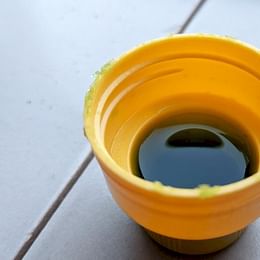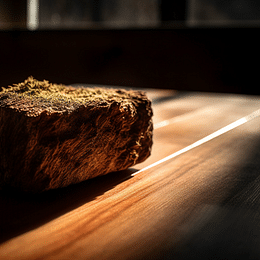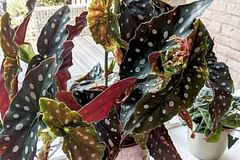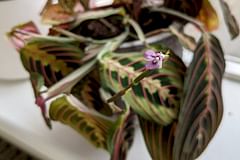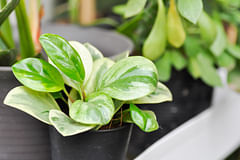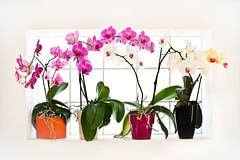How to care for a Zebra Plant (Aphelandra squarrosa)
Learn how to take care of your Aphelandra squarrosa plant, also called the zebra plant, which is an excellent pet-friendly houseplant from the jungle. This guide walks you through everything from watering to sunlight exposure and propagation!
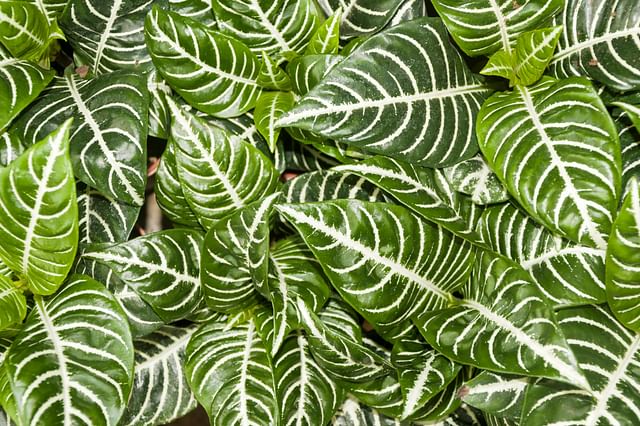
Are you looking for a plant with sharp zebra-like patterns or simply a plant that grows beautiful flowers? Look no further than the Zebra plant, also known as the Aphelandra Squarrosa!
These beautiful plants are easy to care for and can thrive in a variety of settings. In this plant care guide, I'll cover everything you need to know about how to care for your zebra plant. These are the topics we're going to look at together:
Let's get started with this plant care guide and learn how to take care of the Zebra plant in our house!
How often should I water my Zebra Plant?
Zebra plants are native to the tropical rainforests of Brazil, which gives us fantastic clues about the type of care this plant needs. When it comes to watering, it's quite an easy plant!
Your Zebra Plant should be watered about once a week, or when the soil is dry to the touch. Allow the water to completely soak through the soil and drain out the bottom of the pot. If you're unsure if the Zebra Plant needs more water, there's an easy way to check. Touch the top 1-2 inches of soil, and if the soil is moist there's no need to add water.
If the soil is dry, water your Zebra Plant until the water completely drains out of the pot. After you've watered your Zebra plant, allow the excess moisture to drain from the pot for about 5 minutes. Soil should now only hold the moisture that your plant needs and any excess moisture will have drained from the pot.
How can I spot signs of overwatering or underwatering in my Zebra Plant?
Aphelandra squarrosa can be a bit sensitive about their watering needs. Here's how you can spot signs of overwatering and underwatering:
Signs of overwatering
- Yellowing leaves: An early sign of overwatering. The lower leaves will turn yellow first and then other leaves may follow.
- Wilting: Both over and underwatering can cause wilting, but in the case of overwatering, this is due to root rot which makes it difficult for the plant to take up water and nutrients.
- Mushy base or roots: If the plant feels mushy at the base, it's a sign of rot, usually starting from the roots due to excess water.
- Fungus or mold: Excess moisture can create the perfect environment for fungus or mold on the soil surface.
- Standing water: If you notice water standing in the pot tray long after watering, it tells you that the plant is getting more water than it needs. Remove this water soon to prevent root rot.
Signs of underwatering
- Dry, brittle leaves: The leaves of the Zebra Plant will start to feel dry to the touch and may become brittle or crispy, especially around the edges.
- Drooping: The plant will droop to try to preserve moisture. Unlike with overwatering, the plant will perk up after watering.
- Slow growth or stunted growth: Too little water will slow down the Zebra Plant's growth or halt it altogether.
- Leaf curling: Leaves may start to curl inward as they try to reduce their surface area and keep moisture.
- Dry soil: If the soil feels dry several inches down or pulls away from the edge of the pot, it's a clear sign the plant isn't getting enough water.
How much sun should my Zebra Plant get?
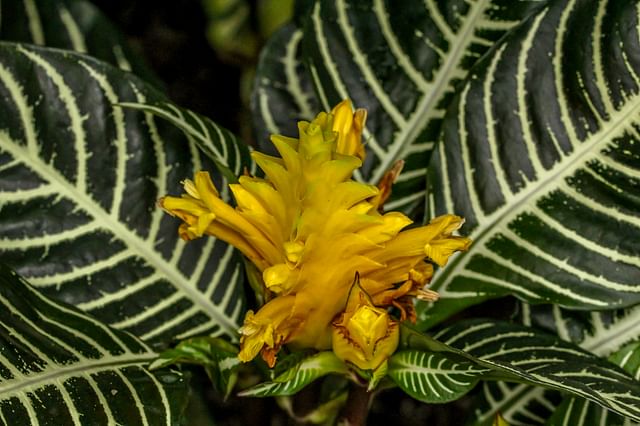
The zebra plant naturally grows under canopy trees, in warm and humid environments. Because it naturally grows in this environment, your Zebra Plant likes bright, indirect sunlight. It will tolerate some direct sun, but not for too long as too much direct sun can scorch the leaves. If the leaves start to turn yellow or brown, I recommend moving the Zebra Plant to an area with more shade.
The perfect spot for your Zebra plant in your house is in a room with a west- or south-facing window. These rooms get the brightest light during the day, which is a great spot for this plant. Again, make sure this plant isn't getting any direct sunlight by placing it behind a thin curtain or another shaded spot.
What temperature range is ideal for a Zebra Plant?
Zebra Plants love it warm and humid, just like their tropical home. They're happiest during the day when it's between 18 to 27℃ (65 to 80℉). At night, they're okay with it being a bit cooler, but keep it above 15℃ (60℉). If it gets too chilly for too long, they start to stress out, dropping leaves or just not growing well.
To keep your Zebra Plant happy and healthy, make sure it stays at just the right temperature. That means keeping it away from drafty spots, direct hits from the AC, or too close to anything that gets hot and could dry it out or make the temperature jump around.
Warmth matters, but don't forget about humidity. Let's look at what your Zebra plant likes when it comes to humidity.
What is the ideal range for humidity?
As we saw earlier, Zebra plants are all about warmth and humidity, just like their home in Brazil's tropical rainforests. They love it when the humidity is between 60% to 70%. Keeping the air humid around them is the secret to having a happy, healthy Zebra Plant without brown and crispy leaves.
How do I maintain humidity levels for my Zebra Plant?
To keep the humidity levels for your Zebra Plant at the right level, you can use any of these methods:
- Misting: Regularly misting your Zebra Plant can help increase the humidity around the plant. But, it's important to mist in the morning so the leaves have time to dry during the day. This reduces the risk of fungal diseases.
- Pebble tray: Place a tray filled with pebbles and water beneath your plant's pot. Make sure the bottom of the pot isn't touching the water. As the water evaporates, it will increase the humidity around the plant.
- Humidifier: Using a humidifier is one of the most effective ways to control humidity levels in your home. Place it near your Zebra Plant to provide a consistent source of humidity.
- Grouping plants: Placing plants closely together creates a microclimate with higher humidity, as they release moisture through transpiration.
- Avoid dry air: Keep your plant away from sources of dry air, such as heaters or air conditioning vents, especially during winter when indoor air tends to be drier.
It might take some practice to find the right humidity levels for your plant. To make it easier, you can use a hygrometer. This tells you exactly if the air is in the right humidity range.
What kind of soil should I use for my Zebra Plant?
The ideal soil for a Zebra Plant should be light and well-draining but also hold onto water for a few days. You can find pre-mixed bags of soil in your local gardening stores. You can also mix your own soil to make sure it will be well-draining and retain enough moisture.
To make your own soil, I recommend adding 1 part potting soil, 1 part peat moss, and 1 part perlite. These ingredients help the soil to be well-draining for your houseplants, but will also drain any excess moisture to the bottom of the pot quickly. This will provide the best environment for your Zebra Plant.
The well-draining soil is very important for the Zebra plant because it's quite sensitive to overwatering. The light soil should hold onto some moisture to keep the plant hydrated, but drain the rest of the moisture. This will prevent overwatering and keep your plant happy.
What kind of fertilizer should I use for my Zebra Plant?
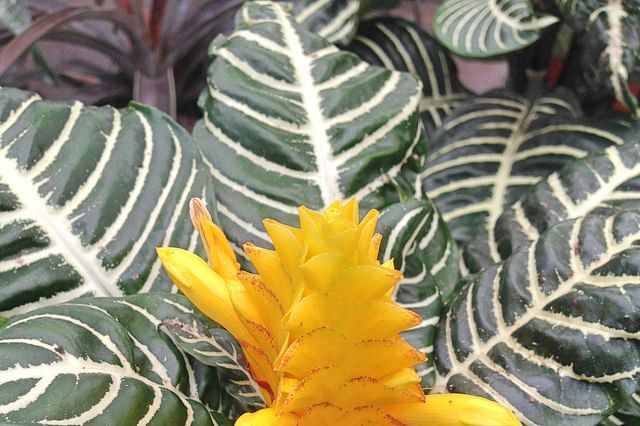
Fertilizing your plant is necessary to keep it healthy during the growing season, spring and summer. When you're fertilizing your plant, you're giving it enough nutrients to grow, but also recover from pests. Like most other plants, the Zebra plant also needs to be fertilized regularly.
Fertilize your Zebra Plant every month during the growing season with a general houseplant fertilizer. My favorite type of fertilizer to use for my houseplants is a liquid fertilizer: fertilizer that you add to the water you're using to water your plants. It's convenient since you're already watering your plant, but it's also a precaution.
If you use fertilizer sticks/spikes or any other slow-release fertilizer, you can't control the dosage. In rare cases, this can lead to overfertilizing your plant, which can damage your plants' roots and kill them. By adding liquid fertilizer to the water, you can make it stronger or more diluted as you see fit.
It's also important to remember not to use fertilizers in autumn and winter. During its dormant season, the Zebra Plant won't use these nutrients and they will instead sit in the soil. This can lead to salt build-up and limit its growth, or even kill the plant.
Are there any specific pruning methods for a Zebra Plant?
Pruning your Zebra Plant is key to keeping it looking good, helping it grow bushy and stay healthy. Don't worry, you don't need any fancy pruning skills. Just stick to a few simple tricks, and you'll have your Zebra Plant looking vibrant and full of life in no time.
When to prune
- Timing: The best time to prune your Zebra Plant is in the early spring, just before the growing season begins. This timing helps the plant recover quickly and puts its energy into new growth.
- After flowering: If your Zebra Plant has flowered, it's a good idea to prune it after the blooms have faded. This helps encourage the plant to focus its energy on foliage growth.
How to prune
- Remove dead or yellow leaves: Regularly check your Zebra Plant for any leaves that are yellowing or dead and gently remove them by snipping at the base of the stem. This helps the plant direct its energy to healthier parts.
- Prune for shape: If your Zebra Plant is getting leggy or you want to encourage a bushier shape, you can prune the longer stems. Cut just above a leaf node (the point on the stem where leaves emerge) using clean, sharp scissors or pruning shears.
- Cut back leggy stems: For stems that are particularly long or stretching out too much, cutting them back to about half their length can encourage new side shoots to form, leading to a fuller plant.
- Top pruning: You can also prune the top off the plant if it's getting too tall. This encourages the growth of new shoots lower down on the plant.
Post-pruning care
- Watering: After pruning, water your Zebra Plant thoroughly. This helps reduce stress on the plant and supports recovery and new growth.
- Light: Make sure your pruned Zebra Plant continues to receive bright, indirect light to support its growth.
- Humidity: Maintaining high humidity around the plant will also aid in its recovery and new growth, as Zebra Plants thrive in humid conditions.
When pruning a zebra plant, always make sure to use clean tools to avoid spreading pests and diseases, and don't prune more than 1/3 of the plant to prevent stressing it out.
How can you propagate a Zebra plant?
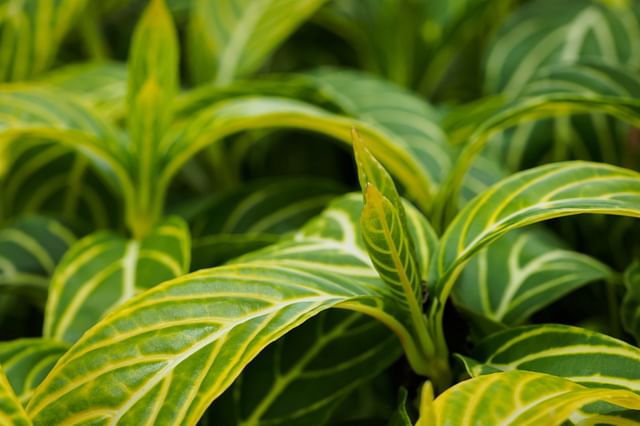
If you've found a Zebra plant and you want to propagate it to get more of them, there are a few ways to go about this. You can propagate a Zebra plant through air layering or stem cuttings.
When you choose to take cuttings, you should plant them in a mix of perlite and peat moss. This makes sure your cutting stays moist for longer. If you can, cover the cutting to trap the humidity around the cutting and place it in an area with bright, but indirect sunlight.
Another way to propagate your Zebra plant is to do air layering. Air layering is a more advanced way to propagate your plant and can take some practice. Essentially, you need to find a healthy stem and remove some of the leaves from that stem. The leaves use nutrients, but you need to preserve nutrients to grow roots.
Make a small cut halfway into this healthy stem and place something in the cut to keep it open. A toothpick is a very popular way to keep this cut open. Then add some growth hormone to the cut, wrap the cut with moist sphagnum moss, and wrap everything with plastic wrap.
The plastic traps the moisture around the cut and this will slowly start to grow roots out of the cut in the stem. Once you see roots grow from the cut, you can cut the stem off and plant it in a new pot.
How often do I need to repot my Zebra Plant?
Your Zebra Plant will need to be repotted every two to three years. I recommend that you repot when the plant becomes too big for its pot, causing the roots to become pot-bound or rootbound. When repotting, be sure to use a well-draining potting mix.
Remove the plant from its current pot and loosen the soil around the root ball. Place the plant in the new pot and fill in around the roots with the potting mix. Tamp down lightly so that the soil is firm, but not packed too tightly. Water thoroughly to help settle the soil and then continue to water as needed based on your climate and the plant's needs.
You may experience that your plant needs time to settle in its new pot. This looks like stunted growth or drooping leaves. Don't panic and don't change your plant care routine! The plant will need some time to adjust to its new growing environment and any additional change could make the recovery take longer or even kill the plant in the worst case.
Tips to promote flowering in a Zebra Plant
Getting the zebra plant to flower is all about mimicking its natural, tropical environment. Make sure it's getting plenty of bright, indirect sunlight. Keep the air around it nice and humid, keep the soil lightly moist and when it's growing season, feed it with some balanced fertilizer. Then, when winter hits, ease up on the watering and feeding to give it a little break.
Proper hygiene for a Zebra Plant

Cleaning your Zebra Plant's leaves is important for its health. Dust and dirt block sunlight and reduce the plant's ability to photosynthesize. This can also clog leaf pores, which could make the plant prone to pests or diseases.
To clean, gently hold each leaf and wipe both sides with a soft, damp cloth. For small plants, a gentle lukewarm shower works too, but avoid soaking the soil. Drain well after showering to prevent waterlogging.
If there's a lot of dust or sticky debris, a tiny drop of mild liquid soap mixed with water can help. Just be sure to rinse off any soap with a clean, wet cloth.
Aim to clean the leaves once every few weeks to keep your plant healthy and looking good. Regular cleaning supports vibrant growth and overall well-being.
What kind of pests do Zebra Plants suffer from?
Zebra plants, like many other tropical plants, are attractive plants for pests. Tropical plants often store a lot of moisture, which is a goldmine for many pests. Zebra Plants can suffer from mealybugs, aphids, and spider mites.
If your Zebra Plant is being bothered by pests, there are a few things you can do to get rid of them. You can try using a strong stream of water from your faucet to dislodge them or use a pesticide made specifically for houseplants.
I recommend using a natural pesticide, neem oil, or insecticidal soap. Be sure to read the instructions on the package carefully, and always use caution when handling pesticides. When you notice any pests on your houseplant, try to isolate your plant from the other plants to prevent the pests from spreading.
Is a Zebra plant safe for pets?
Zebra Plants are safe for both dogs and cats. The ASPCA (American Society for the Prevention of Cruelty to Animals) has listed the Zebra Plant as non-toxic to both dogs and cats. This makes the Zebra plant one of the most exotic houseplants that are completely safe for your pets! You can bring the jungle indoors without worrying about having your pets around your Zebra plant.
Conclusion
Zebra plants are beautiful tropical plants that will make a great addition to any home! They're not the easiest plants to take care of, but by following the tips in this plant care guide, it'll be a lot easier. The Zebra plant prefers a bright indirect spot in your house. It loves moist, but not wet soil, and it is quite easy to propagate! The best part? It's completely safe to have around your pets! With proper care, it will thrive and bring some tropical flair to your home!
If you found this plant care guide useful, please share it with your friends, family, or co-workers to help them take care of their plants as well!
Thank you for reading this post! I hope it helps you to keep your plants healthy and beautiful! If you're looking for more guides on specific plants, you can always request a plant guide to get a guide for the plant you have trouble with.
Test your plant care knowledge
Quiz completed!
Want to learn more? Sign up for my newsletter to receive free tips in your inbox!
Sign up now!